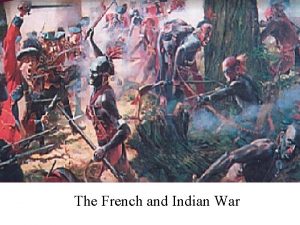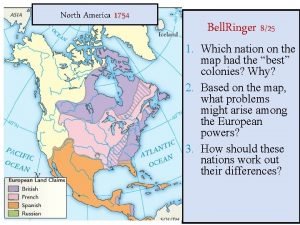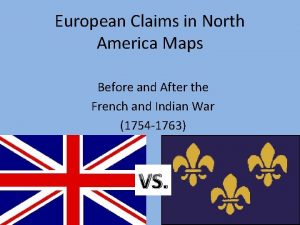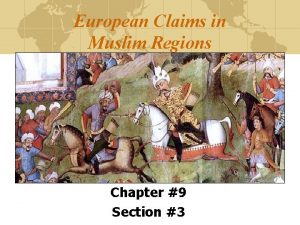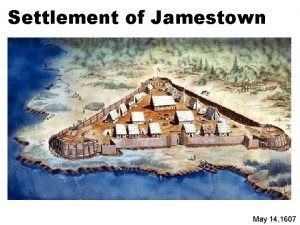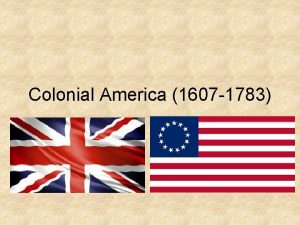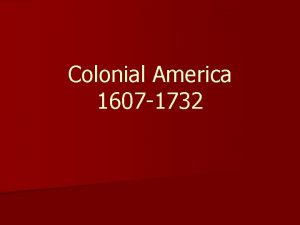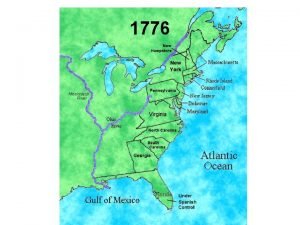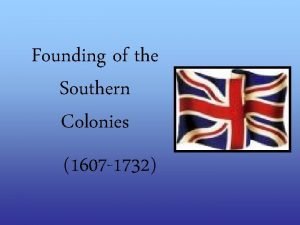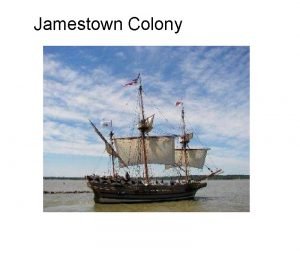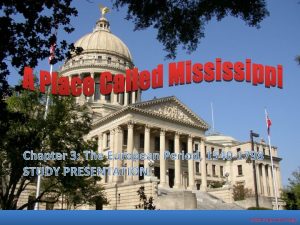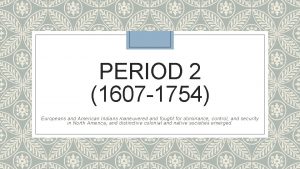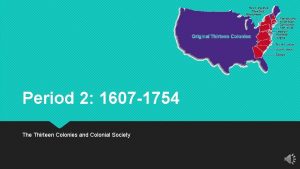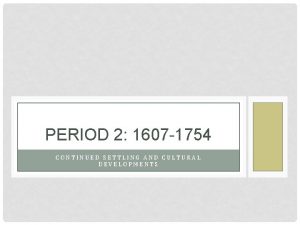APUSH Period 2 1607 1754 European Claims and






















- Slides: 22

APUSH Period 2 1607 -1754

European Claims and settlements in the Americas

Big Picture 2. 1: Europeans developed a variety of colonization and migration patterns, influenced by different imperial goals, cultures, and the varied North American environments where they settled, and they competed with each other and American Indians for resources. This will break down into 2. 1. I, and 2. 1. I breaks down into 2. 1. I. A, 2. 1. I. B, 2. 1. I. C, 2. 1. I. D, and 2. 1. I. E.

2. 1. I. Spanish, French, Dutch, and British colonizers had different economic and imperial goals involving land labor that shaped the social and political development of their colonies as well as their relationships with native populations. A. Spanish efforts to extract wealth from the land led them to… B. French and Dutch colonial efforts involved… C. English colonization efforts attracted…

2. 1. I. A

Mulattos too.




2. 1. I. B


2. 1. I. C

New England Colonies Middle Colonies Southern Colonies

Great Migration


Demographic Changes Source: United States Historical Census Data Base Populations in the American Colonies of 1700, 1755 & 1775 [25][26][27] 1700 Ancestry Percent 1755 Ancestry Percent 1775 Ancestry Percent English and Welsh 80. 0% English and Welsh 52. 0% English 48. 7% African 11. 0% African 20. 0% Dutch 4. 0% German 7. 0% Scots-Irish 7. 8 % Scottish 3. 0% Scots-Irish 7. 0% German 6. 9% Other European 2. 0% Irish 5. 0% Scottish 6. 6 % Scottish 4. 0% Dutch 2. 7% Dutch 3. 0% French 1. 4% Other European 2. 0% Swedish 0. 6% Total 100% Other 5. 3% Total 100%

Social Mobility in the Colonies 1. 2. 3. 4. 5. 6. Gentry Artisans Yeomen Manual workers/hired hands Indentured servants Slaves

Colonial Folkways • Language and customs • Protestantism • Some ethnic and religious toleration • Unusual social mobility • Habit of local, self-government • Effect of physical distance from England

Religious Freedom? • New England—issues with toleration • Mid-Atlantic Colonies—general toleration • Southern Colonies (including the Chesapeake)—general toleration

Colonial Agriculture • New England—smaller, subsistence farms • Mid-Atlantic—larger, prosperous farming (the Breadbasket) • South—larger, cash-crops and slavery

Relations with American Indians • Separate peoples ØMutual suspicion ØLimited interaction ØLess missionary emphasis • Periods of sharp conflict ØPowhatan Wars ØPequot War ØBeaver Wars ØKing Phillip’s War

2. 1. II In the 17 th Century, early British colonies developed along the Atlantic coast, with regional differences that reflected the various environmental, economic, cultural, and demographic factors. A. B. C. D. The Chesapeake and North Carolina colonies… The New England colonies… The middle colonies… The colonies of the southernmost Atlantic coast and the British West Indies… E. Distance and Britain’s initially lax attention led to…
 1754 to 1800 apush
1754 to 1800 apush Effective persuasive claim letters
Effective persuasive claim letters French and indian war
French and indian war 1754 lulu love
1754 lulu love North america 1754 map worksheet
North america 1754 map worksheet European claims in north america map
European claims in north america map European claims in muslim regions
European claims in muslim regions Expansion of the united states of america 1607 to 1853 map
Expansion of the united states of america 1607 to 1853 map Các chữ số la mã
Các chữ số la mã May 14 1607
May 14 1607 1783-1607
1783-1607 1732-1607
1732-1607 1776-1607
1776-1607 1491 to 1607 timeline
1491 to 1607 timeline 1733-1607
1733-1607 Carolina charter of 1663
Carolina charter of 1663 King james 1607
King james 1607 Wingapoo
Wingapoo Chapter 3: the european period 1540-1798
Chapter 3: the european period 1540-1798 A&p flix activity: resting membrane potential
A&p flix activity: resting membrane potential When is the relative refractory period
When is the relative refractory period Trustee period and royal period
Trustee period and royal period Prehistory timeline
Prehistory timeline


